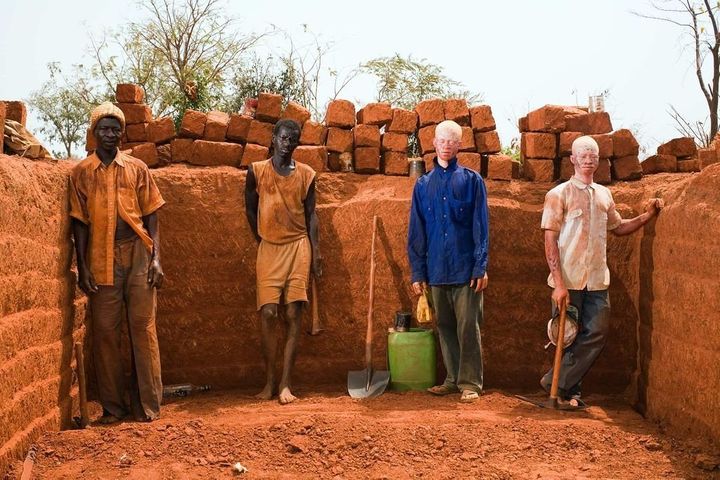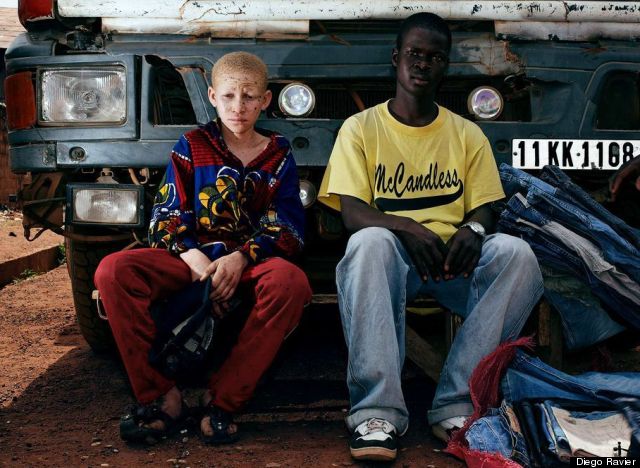
If you are intensely misunderstood, you want Diego Ravier to be your photographer.
He doesn't just identity subjects to photograph. He helps his subjects find identity. That was the case with persons affected by albinism, the subject of a recent Huffington magazine photo essay by Ravier, a France based freelance photographer with an anthropologist’s heart and an artist’s soul.
He spent three months in Africa on assignment with Order of Malta, who sent him to document floods in Burkina Faso. During his stay, the French non-profit also asked him to feature doctors who work with Albinos and as his original assignment completed, he turned his attention to the albinos themselves, a group of people often seen as outcasts in a country where a genetic disorder that creates pale white skin is viewed superstitiously by fellow Africans who make Albinos the subject of economic, physical and social turmoil. He wants to know, "what is normal?"
Ravier doesn’t believe he can answer that question completely but he watches the question unfold with his camera, which he took into homes, schools and workplaces of albinos who didn’t want to be photographed at first. He told the Huffington Post, “The pictures maybe take ten minutes but you spend hours talking to them. After four hours of talking, they say yes I want to be apart of this picture.”

You photographed an albino 10-year-old albino named Isaac. He has black parents and half of his siblings are albino. What was that like?
Look how is he looking to the camera. They don’t want to be the antagonist of the story. The other guy is really proud to be in the picture, Issac is not really proud. He’s looking at the camera saying, “Why am I not the other one?" They want to be normal.
What did you learn through your experience?
The albinos in Burkina Faso showed to me that every person has dignity. The albinos there kept their dignity, even though they were regarded as freaks and outcasts by general society. It was our job as photographers to show this dignity, and not only the misery of their living conditions. That is why we photographed them using methods you would also use photographing a politician or a business manager. We used flashes and photography lamps similar to a fashion shoot. Everybody wants to look good on pictures, and albinos are no exception. We did not want to hide their disorder either. We chose to take photos of them together with their relatives. That way, the person who sees the photograph can more easily understand what is different about the appearance of an albino. You can see that there is a difference – but you do not have to make a negative judgment.

Can you explain more about the caption on this adorable photo? In Huffington it says it’s hard to maintain health while living in poverty.
She’s three years old and malnourished. Her parents are farmers. They didn’t have enough food to feed their kids. You can see a little bit of red on her arm. That is the beginning of her tumor. Since albinos have sensitive skin, they develop skin cancer very easily if they do not stay out of the sun, or use very high-level sun protection, both of which are difficult in a place like Burkina Faso. Albinos have no melanin in their skin, which not only makes the skin look dark, but is also a protective pigment.
What is the most important thing you want people to know about albinos in Africa?
It is cruel and unjust to label somebody as abnormal just because he or she suffers from a genetic disorder. Our idea of what is normal has been shaped by centuries of culture, religion and tradition. Some religious rituals that we have seen in Burkina Faso are very hard for us to understand, they are related to animism, which is the belief that every human, animal or plant possesses a soul (“anima”) or spirit, which are then worshipped. Some prejudices about albinos are related to animism. Another source of prejudices is the history of colonialism – simply put, the experience of black Africans seeing white people come to their countries and bring them misery and exploitation. It is important for the people there to understand that albinos have nothing to do with these religious or historical conditions.

What is going on this picture?
The mother is protecting her son. Imagine you go outside and you are completely different. If people believe your hair is lucky, they try to take your hair. In some cases, they don’t allow them to go outside of the house. They don’t have friends outside of their family. There’s no socialization outside but that is the point - what is normal?
How did you become a photographer in the first place?
At 28, I switched careers after not any more motivated at my job as a project manager for one of the biggest European car producers. The job was well paid, but not the kind of work that I wanted to do forever. After I quit, I tried to take a sailing course in England. My next idea was to become a photographer. I wanted to go out into the world to see how people are living in our society.
I went to Paris to study photography in a one-year program. Next to my student housing, there was a clinic. When I looked out of my flat's window, I saw people inside the clinic that could hardly move and used machines to help them walk in the yard. I later learned that they had hurt their backbone during accidents. Fascinated, I went over to the clinic and talked to the people working there who happened to be from the Order of Malta. They became the organization that gave me my first big reporting job when they sent me to Burkina Faso.
It pays to look out of your window sometimes.